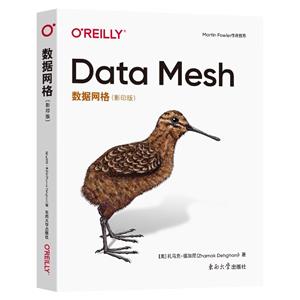掃一掃
關注中圖網
官方微博
本類五星書更多>
-
>
全國計算機等級考試最新真考題庫模擬考場及詳解·二級MSOffice高級應用
-
>
決戰行測5000題(言語理解與表達)
-
>
軟件性能測試.分析與調優實踐之路
-
>
第一行代碼Android
-
>
JAVA持續交付
-
>
EXCEL最強教科書(完全版)(全彩印刷)
-
>
深度學習
數據網格(影印版) 版權信息
- ISBN:9787576605938
- 條形碼:9787576605938 ; 978-7-5766-0593-8
- 裝幀:一般膠版紙
- 冊數:暫無
- 重量:暫無
- 所屬分類:>
數據網格(影印版) 內容簡介
我們正處于數據的拐點,現今的數據管理解決方案已經不符合組織的復雜性、數據源的激增以及我們希望通過人工智能和分析從數據中獲得價值的愿景。在這本實踐用書中,作者Zhamak Dehghani介紹了數據網格,這是一種去中心化的社會技術范式,取自現代分布式架構,為大規模獲取、共享、訪問和管理分析數據提供了新方法。Dehghani指導從業者、架構師、技術領導人和決策者從傳統大數據架構轉向分布式多維分析數據管理方法。數據網格將數據視為產品,將領域視為主要關注點,應用平臺思維創建自助式數據基礎架構,并引入數據治理的聯合計算模型。
數據網格(影印版) 目錄
Foreword
Preface
Prologue: Imagine Data Mesh
Part I. What Is Data Mesh?
1. Data Mesh in a Nutshell
The Outcomes
The Shifts
The Principles
Principle of Domain Ownership
Principle of Data as a Product
Principle of the Self-Serve Data Platform
Principle of Federated Computational Governance
Interplay of the Principles
Data Mesh Model at a Glance
The Data
Operational Data
Analytical Data
The Origin
2. Principle of Domain Ownership
A Brief Background on Domain-Driven Design
Applying DDD's Strategic Design to Data
Domain Data Archetypes
Source-Aligned Domain Data
Aggregate Domain Data
Consumer-Aligned Domain Data
Transition to Domain Ownership
Push Data Ownership Upstream
Define Multiple Connected Models
Embrace the Most Relevant Domain Data: Don't Expect a Single Source of Truth
Hide the Data Pipelines as Domains' Internal Implementation
Recap
3. Principle of Data as a Product
Applying Product Thinking to Data
Baseline Usability Attributes of a Data Product
Transition to Data as a Product
Include Data Product Ownership in Domains
Reframe the Nomenclature to Create Change
Think of Data as a Product, Not a Mere Asset
Establish a Trust-But-Verify Data Culture
Join Data and Compute as One Logical Unit
Recap
4. Principle of the Self-Serve Data Platform
Data Mesh Platform: Compare and Contrast
Serving Autonomous Domain-Oriented Teams
Managing Autonomous and Interoperable Data Products
A Continuous Platform of Operational and Analytical Capabilities
Designed for a Generalist Majority
Favoring Decentralized Technologies
Domain Agnostic
Data Mesh Platform Thinking
Enable Autonomous Teams to Get Value from Data
Exchange Value with Autonomous and Interoperable Data Products
Accelerate Exchange of Value by Lowering the Cognitive Load
Scale Out Data Sharing
Support a Culture of Embedded Innovation
Transition to a Self-Serve Data Mesh Platform
Design the APIs and Protocols First
Prepare for Generalist Adoption
Do an Inventory and Simplify
Create Higher-Level APIs to Manage Data Products
Build Experiences, Not Mechanisms
……
Part II. Why Data Mesh?
Part III. How to Design the Data Mesh Architecture
Part IV. How to Design the Data Product Architecture
Part V. How to Get Started
Index
Preface
Prologue: Imagine Data Mesh
Part I. What Is Data Mesh?
1. Data Mesh in a Nutshell
The Outcomes
The Shifts
The Principles
Principle of Domain Ownership
Principle of Data as a Product
Principle of the Self-Serve Data Platform
Principle of Federated Computational Governance
Interplay of the Principles
Data Mesh Model at a Glance
The Data
Operational Data
Analytical Data
The Origin
2. Principle of Domain Ownership
A Brief Background on Domain-Driven Design
Applying DDD's Strategic Design to Data
Domain Data Archetypes
Source-Aligned Domain Data
Aggregate Domain Data
Consumer-Aligned Domain Data
Transition to Domain Ownership
Push Data Ownership Upstream
Define Multiple Connected Models
Embrace the Most Relevant Domain Data: Don't Expect a Single Source of Truth
Hide the Data Pipelines as Domains' Internal Implementation
Recap
3. Principle of Data as a Product
Applying Product Thinking to Data
Baseline Usability Attributes of a Data Product
Transition to Data as a Product
Include Data Product Ownership in Domains
Reframe the Nomenclature to Create Change
Think of Data as a Product, Not a Mere Asset
Establish a Trust-But-Verify Data Culture
Join Data and Compute as One Logical Unit
Recap
4. Principle of the Self-Serve Data Platform
Data Mesh Platform: Compare and Contrast
Serving Autonomous Domain-Oriented Teams
Managing Autonomous and Interoperable Data Products
A Continuous Platform of Operational and Analytical Capabilities
Designed for a Generalist Majority
Favoring Decentralized Technologies
Domain Agnostic
Data Mesh Platform Thinking
Enable Autonomous Teams to Get Value from Data
Exchange Value with Autonomous and Interoperable Data Products
Accelerate Exchange of Value by Lowering the Cognitive Load
Scale Out Data Sharing
Support a Culture of Embedded Innovation
Transition to a Self-Serve Data Mesh Platform
Design the APIs and Protocols First
Prepare for Generalist Adoption
Do an Inventory and Simplify
Create Higher-Level APIs to Manage Data Products
Build Experiences, Not Mechanisms
……
Part II. Why Data Mesh?
Part III. How to Design the Data Mesh Architecture
Part IV. How to Design the Data Product Architecture
Part V. How to Get Started
Index
展開全部
數據網格(影印版) 作者簡介
扎馬克·德加尼(Zhamak Dehghani)是Thoughtworks的技術主管,專注于分布式架構和新興技術。她是數據網格的創始人。
書友推薦
- >
山海經
- >
月亮虎
- >
史學評論
- >
大紅狗在馬戲團-大紅狗克里弗-助人
- >
回憶愛瑪儂
- >
企鵝口袋書系列·偉大的思想20:論自然選擇(英漢雙語)
- >
我從未如此眷戀人間
- >
有舍有得是人生
本類暢銷

















